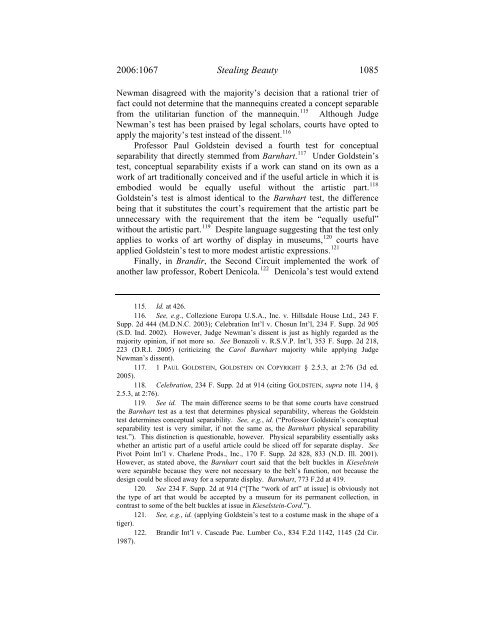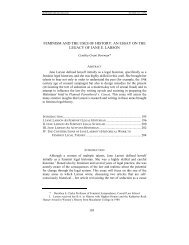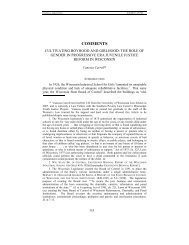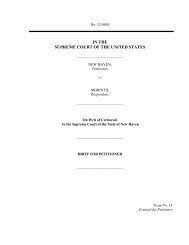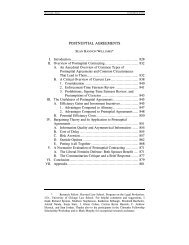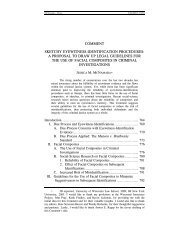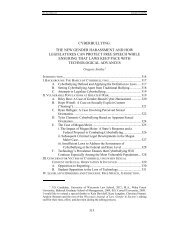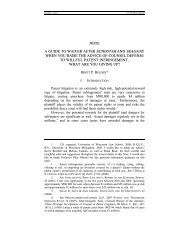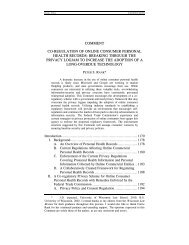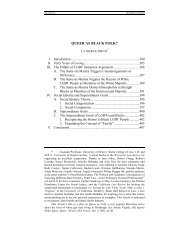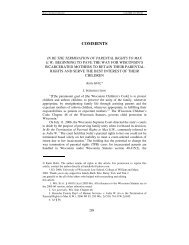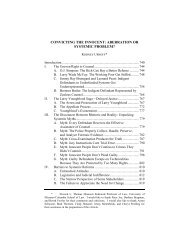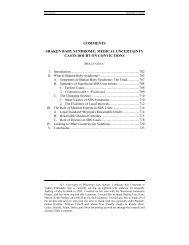Stealing Beauty: Pivot Point International v ... - UW Law School
Stealing Beauty: Pivot Point International v ... - UW Law School
Stealing Beauty: Pivot Point International v ... - UW Law School
Create successful ePaper yourself
Turn your PDF publications into a flip-book with our unique Google optimized e-Paper software.
2006:1067 <strong>Stealing</strong> <strong>Beauty</strong> 1085<br />
Newman disagreed with the majority’s decision that a rational trier of<br />
fact could not determine that the mannequins created a concept separable<br />
from the utilitarian function of the mannequin. 115 Although Judge<br />
Newman’s test has been praised by legal scholars, courts have opted to<br />
apply the majority’s test instead of the dissent. 116<br />
Professor Paul Goldstein devised a fourth test for conceptual<br />
separability that directly stemmed from Barnhart. 117 Under Goldstein’s<br />
test, conceptual separability exists if a work can stand on its own as a<br />
work of art traditionally conceived and if the useful article in which it is<br />
embodied would be equally useful without the artistic part. 118<br />
Goldstein’s test is almost identical to the Barnhart test, the difference<br />
being that it substitutes the court’s requirement that the artistic part be<br />
unnecessary with the requirement that the item be “equally useful”<br />
without the artistic part. 119 Despite language suggesting that the test only<br />
applies to works of art worthy of display in museums, 120 courts have<br />
applied Goldstein’s test to more modest artistic expressions. 121<br />
Finally, in Brandir, the Second Circuit implemented the work of<br />
another law professor, Robert Denicola. 122 Denicola’s test would extend<br />
115. Id. at 426.<br />
116. See, e.g., Collezione Europa U.S.A., Inc. v. Hillsdale House Ltd., 243 F.<br />
Supp. 2d 444 (M.D.N.C. 2003); Celebration Int’l v. Chosun Int’l, 234 F. Supp. 2d 905<br />
(S.D. Ind. 2002). However, Judge Newman’s dissent is just as highly regarded as the<br />
majority opinion, if not more so. See Bonazoli v. R.S.V.P. Int’l, 353 F. Supp. 2d 218,<br />
223 (D.R.I. 2005) (criticizing the Carol Barnhart majority while applying Judge<br />
Newman’s dissent).<br />
117. 1 PAUL GOLDSTEIN, GOLDSTEIN ON COPYRIGHT § 2.5.3, at 2:76 (3d ed.<br />
2005).<br />
118. Celebration, 234 F. Supp. 2d at 914 (citing GOLDSTEIN, supra note 114, §<br />
2.5.3, at 2:76).<br />
119. See id. The main difference seems to be that some courts have construed<br />
the Barnhart test as a test that determines physical separability, whereas the Goldstein<br />
test determines conceptual separability. See, e.g., id. (“Professor Goldstein’s conceptual<br />
separability test is very similar, if not the same as, the Barnhart physical separability<br />
test.”). This distinction is questionable, however. Physical separability essentially asks<br />
whether an artistic part of a useful article could be sliced off for separate display. See<br />
<strong>Pivot</strong> <strong>Point</strong> Int’l v. Charlene Prods., Inc., 170 F. Supp. 2d 828, 833 (N.D. Ill. 2001).<br />
However, as stated above, the Barnhart court said that the belt buckles in Kieselstein<br />
were separable because they were not necessary to the belt’s function, not because the<br />
design could be sliced away for a separate display. Barnhart, 773 F.2d at 419.<br />
120. See 234 F. Supp. 2d at 914 (“[The “work of art” at issue] is obviously not<br />
the type of art that would be accepted by a museum for its permanent collection, in<br />
contrast to some of the belt buckles at issue in Kieselstein-Cord.”).<br />
121. See, e.g., id. (applying Goldstein’s test to a costume mask in the shape of a<br />
tiger).<br />
122. Brandir Int’l v. Cascade Pac. Lumber Co., 834 F.2d 1142, 1145 (2d Cir.<br />
1987).


